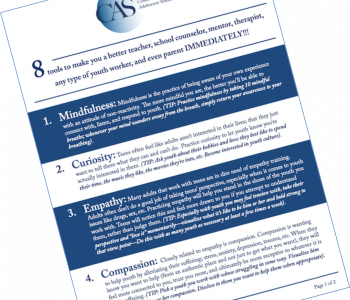

Sam Himelstein, PhD
Sam Himelstein is the founder and CEO of the Center for Adolescent Studies, Inc. He is passionate about working with youth and training the professionals that serve them.
A Brief History of Trauma for Youth Providers
The field of trauma studies, as well as the application to trauma treatment with young people, is still very much in its infancy. Posttraumatic Stress Disorder (PTSD) is often discussed synonymously with trauma. However, PTSD as a diagnosis rarely does justice to the experience of young people, who often exhibit a complex set of behaviors and trauma adaptations not covered under the standard definition of PTSD. Understanding how trauma is diagnosed and treated is important for those of us wanting to implement mindfulness practices into our work youth. In order to be a trauma-informed mindfulness facilitator, it’s useful to have at least a general idea of how trauma has been studied and conceptualized with young people.
Below I outline a few historical events related to the field of trauma that help with contextualizing the layered, multi-faceted experiences that lead to trauma in youth.
‘Hysteria’ and Abuse
In the late 19th century, there was a common condition called hysteria, which from the patriarchal view of the time, only women suffered from. In “The Aetiology of Hysteria,” Sigmund Freud stated that sexual abuse was the cause of this hysterical syndrome once thought of as something simply “wrong” with women. Unfortunately, Freud gave up this theory because he was ridiculed by his colleagues. He found that sexual abuse was such a common experience among his patients that his findings threatened the fragility of the bourgeois class of the time so he recanted his theory. Instead, he stated that the hysterical symptoms actually came from the sexual fantasies of his women patients and not from long-term abuse. His recantation was an extreme disservice to his patients and to the field of trauma.
Rape Trauma Syndrome
Another important historical event was the publication of a 1974 paper titled “Rape Trauma Syndrome,” in which Lynda Burgess and Anna Holmstrom described the experiences of women who’d been sexually assaulted. They reported symptoms including but not limited to:
- flashbacks,
- anxiety,
- nausea,
- numbness,
- bewilderment,
- helplessness,
- mood swings,
- panic attacks, and
- insomnia
Unfortunately nothing else at the time was published and the term “Rape Trauma Syndrome” only gained traction colloquially and not formally in the Diagnostic and Statistical Manual of Mental Disorders (DSM). This was unfortunate because as presented next, the introduction of PTSD into the DSM did not take into account the primary experiences of women (or of children who’ve been sexually abused).
Post-Traumatic Stress Disorder
In the 1970s, many returning Vietnam Veterans suffered from what’s now known as Posttraumatic Stress Disorder (PTSD). Prior to this, PTSD was commonly described as “shell shock.”
PTSD is characterized by exposure to a traumatic event, as well as:
- intrusion symptoms, like nightmares or ‘flashbacks’,
- avoidance symptoms such as attempts to avoid people, places, and even thoughts related to a traumatic experience, and
- arousal symptoms like the physiological activation of the central nervous system associated with exaggerated startle responses, hyper-vigilance, and emotional and physical outbursts, and
- Negative shifts in cognition and mood, such as depression, changes in worldview, difficulty concentrating, etc.
It was combat veterans who came together and got PTSD as a formal diagnosis in the DSM, not psychiatrists and mental health professionals. While this was a huge accomplishment, the diagnosis was naturally oriented toward the experience of men returning from war.
Complex PTSD
In her 1992 book Trauma and Recovery, Judith Herman described Complex PTSD (C-PTSD). C-PTSD symptoms include:
- difficulty in emotional regulation;
- changes in the perception of reality, such as amnesia or flashbacks;
- changes in self-perception, such as shame, guilt, helplessness, aloneness and difference from others;
- preoccupation with revenge;
- isolation, withdrawal, and persistent distrust;
- a loss of faith, and/or sense of despair or hopelessness.
The introduction of C-PTSD was a much needed expansion of the lens of how trauma was being viewed at the time (through men’s experience as a singular, “shock” trauma event) and laid the framework for conceptualizing the often multiple, layered events that children experience over and over.
The Adverse Childhood Experiences (ACEs) Movement
Shortly after Trauma and Recovery was published, some other important work in the trauma movement was getting underway. In the mid 1990s, Dr. Vincent Felitti and Dr. Robert Anda conducted a study originally interested in the intersection between obesity and health. They ended up creating a survey that measured the prevalence rates of what we now know as Adverse Childhood Experiences (ACEs).
Since the original ACEs studies, a plethora of follow-up research has been conducted with other populations, most being youth. This research has shown ACEs to be significantly correlated among youth with suicide attempts, substance use, self-esteem and depression, and incarceration.
The ACEs movement has been a huge contribution to the field of child trauma and as I write this post it still gains momentum. California just elected its very first surgeon general, Nadine Burke Harris, who has built her career serving children and studying ACEs.
Developmental Trauma Disorder
In a 2005 paper titled Developmental Trauma Disorder: Toward a Rational Diagnosis for Children with Complex Trauma Histories, Bessel van der Kolk proposes criteria for diagnosing children who’ve experienced prolonged and multiple traumas. These criteria include multiple or chronic exposure to interpersonal trauma (abandonment, betrayal, physical and/or sexual assaults, emotional abuse, witnessing violence and death).
Symptoms include a triggered pattern of dysregulation in response to trauma cues such as affective, somatic, behavioral, cognitive, interpersonal, and intrapersonal, and functional impairment such as educational impairment, legal, familial, peer, and/or vocational impairment.
Van der Kolk and his colleagues continue to publish about developmental trauma disorder. It is not a current diagnosis in the DSM but hopefully will be one day.
Multigenerational Trauma
Intergenerational trauma is also pertinent to youth work. It isn’t uncommon when working with a young person to hear about the immense amount of suffering the family, and the community in which they live, has undergone for generations back.
In the year 2000, a study titled Wakiksuyapi: Carrying the Historical Trauma of the Lakota was published by Maria Yellow Horse Brave Heart. Brave Heart is a Lakota mental health professional who popularized the term Historical Trauma in the 1980s. The study collected both quantitative and qualitative data from the Lakota tribe, whose ancestors were involved either in the massacre at Wounded Knee in 1890 (where hundreds of indigenous people were massacred and thrown in a large burial ground) or whose ancestors were taken away from their homes and families, sent to boarding schools, and often abused physically, emotionally, and sexually.
Brave Heart conceptualizes the Lakota Historical Trauma Response as a “constellation of features associated with massive group trauma across generations” and study data reported traumatic responses including but not limited to anger, a trauma identity, survivor guilt, somatic reactions, and suicidal ideation.
Related to the structural violence committed against Native Americans is the legacy of oppression against Black Americans starting with the Trans-Atlantic Slave Trade. In 2005 Dr. Joy DeGruy published her seminal text Post Traumatic Slave Syndrome: America’s Legacy of Enduring Injury and Healing. Here, she overviews the genocide and trauma endured by African peoples taken from their land and sold into chattel slavery, the devastating violence Black Americans endured, and the lasting impact of racism long past slavery into the Jim Crow era and to the present day with mass incarceration and the war on drugs.
DeGruy defined Posttraumatic Slave Syndrome (PTSS) as “multigenerational trauma together with continued oppression and absence of opportunity to access the benefits available in society…” DeGruy also reviewed three major symptoms associated with PTSS:
- Vacant Esteem, or the depletion of self-worth, efficacy, and confidence;
- Ever Present Anger, the just-below-the-surface anger associated with being persecuted for over four hundred years; and
- Racist Socialization, the internalized racism and oppression that many Black Americans have been brainwashed into thinking by White America.
This isn’t to say that White youth cannot experience intergenerational trauma through their family lines related to abuse, addiction, poverty, etc. (I have worked with them as well), but rather that youth from Communities of Color deal with substantial societal issues related to racism and oppression that White youth do not.
Conclusion
I hope this brief overview has been useful. It is by no means meant to be exhaustive, just a very brief introduction to the work of some important researchers and clinicians. My hope is that it has been helpful in your conceptualization of how you view trauma; how it presents itself, its contextual underpinning, and how you work with youth.
Join the FREE Resilience Community for Helping Professionals to learn more about trauma-informed care, resilience, mindfulness, building relationships, and more! Our community features self-paced courses, a monthly live Zoom call, a weekly live meditation, and an online platform to connect with other providers/professionals in your field.
Related Posts
Compassion Can Help You Work With Trauma-Impacted Youth
A Critical Intervention for Working with Traumatized Youth

